A Very Secret Trade: The dark story of gentleman collectors in Tasmania
In her captivating book and a piece of truth-telling par excellence, Pybus uncovers the network of colonial men in Tasmania who used their status and laced it with deception and trickery to obtain the Ancestral remains of Palawa men, women and children, and ship them off to Europe … As Pybus notes, there is still much to be uncovered about these devious practices in Tasmania and elsewhere.
READ REVIEW
↓
A Very Secret Trade: The dark story of gentleman collectors in Tasmania
cassandra pybus | 2024
On 14 May 2024 in the dead of night in a Hobart park, a man armed with a saw toppled the statue of former Tasmania Premier William Crowther, cutting him off at the ankles. I am not one to support the defacing of public monuments, but after reading Cassandra Pybus’ superb A Very Secret Trade: The dark story of gentleman collectors in Tasmania, I can understand and appreciate the perpetrator’s motivation and action.
In her captivating book (a follow-up to her recent biography of Truganini) and a piece of truth-telling par excellence, Pybus uncovers the network of colonial men in Tasmania who used their status and laced it with deception and trickery to obtain the Ancestral remains of Palawa men, women and children, and ship them off to Europe. Pybus reveals their true motivations; not the pretence of scientific discovery, but the desire to climb the colonial ladder and build their own wealth and power by satisfying, not only their own desires and demands, but those of surgeons, collectors and curators in the power centres of Europe and England as well.
The list of perpetrators is long and now undistinguished. Crowther, a surgeon and founding member of the Royal Society of Tasmania in 1843 before he became Premier, removed the head of Billy Lanne, an Aboriginal man from the north and north-west of Tasmania, after he died at Hobart in 1869. Intending to send the skull to the Royal College of Surgeons in London, Crowther was thwarted by critical newspaper coverage (not all people in colonial society approved of the practice) and the actions of other Royal Society members who coveted the remains for their own purposes. It was not until 1888 and after Crowther’s death that Lanne’s skull was sent to Europe.
Another whose demands fed the work of “resurrection men” (as the grave robbers were known) was Scottish surgeon and merchant Alexander Berry. I had known of Berry from his occupation in the 1820s of Cullunghutti (aka Coolangatta), a property near the mouth of the Shoalhaven River to the south of Sydney. Berry took an accommodating approach to the original occupiers of Cullunghutti, encouraging them to live and work on the property in relatively safe conditions. But as an adherent of the pseudo-science of phrenology, he was also morbidly fascinated with their remains, raiding graves and sending numerous sets overseas. And as it turns out, the fingers of his fascination extended to Tasmania, where he used contacts cultivated on an earlier visit to obtain three skulls that were sent to institutions in Scotland and London.
A feature of A Very Secret Trade is Pybus’s meticulous documentary research. She has scoured the archives of Australia and Europe in uncovering this story. Pybus acknowledges the silences, pointing out that perpetrators at times realised at least the illegality of their actions, mislabelling boxed remains in shipping manifests to keep the inspectors at bay. This means that the culprits cannot always be securely identified, even when the fact of stolen remains cannot be doubted. But in the majority of cases, Pybus’s careful piecing together of the evidence means that no doubt can be cast on those who she directly accuses.
In 2015 I was fortunate to attend two repatriation ceremonies in Wiradjuri country not far from Wellington and Dubbo in central NSW. Careful negotiations between the Australian Museum (which had acquired the remains) and local Aboriginal land councils led to the return of the Ancestors to their Country from which they had been removed over 100 years before. A telling part of both ceremonies was the smoking of the remains and the dances performed just before the re-interments took place. As it turned out, the man who led the smoking and the dancers were descended from several ancestors from the same area. More than likely they were related to those being re-buried. It brought home to me the enduring ties of Aboriginal people to their Country and the deep meaning and significance they attribute to Ancestral remains. And although not discussed on the day, there is undoubtedly a similar tale of back-room deals and deception that led to the remains being removed in the first place. As Pybus notes, there is still much to be uncovered about these devious practices in Tasmania and elsewhere. And too many sets of remains to be returned home. Let’s hope that happens soon, otherwise monuments similar to Crowther’s may suffer the same fate.
A Very Secret Trade: The dark story of gentleman collectors in Tasmania is published by Allen & Unwin.
Reviewer: Michael Bennett, PHA (NSW & ACT)

